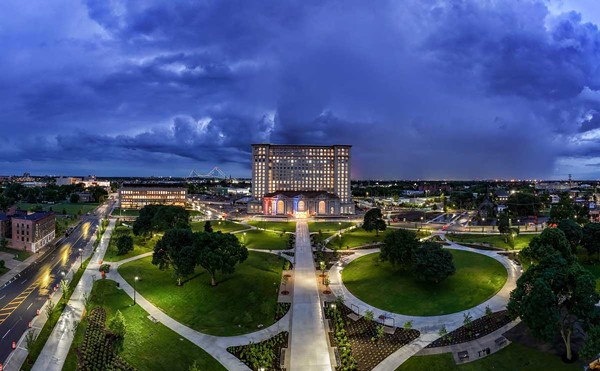Belle Isle, the crown jewel of Detroit, has been the subject of plenty of personal and public opinion lately. It came under state stewardship in February, and controversy has flanked the island ever since.
Still, Belle Isle remains a trove of historic landmarks. Statues line the thoroughfares and green signs mark noteworthy buildings that hold significant meaning to the city. In fact, the park was named to the National Register of Historic Places in February of 1974 largely because of such buildings and monuments.
The Belle Isle Aquarium is one such structure. It stands a slight way off from the intersection of Inselruhe Avenue and Loiter Way, just two miles from downtown Detroit. It seems unimposing, but with a closer inspection proves spectacularly beautiful. Its roof is copper and the facade is made with brick, and intricate stonework adorns its corners. A sign bearing only the word “Aquarium” is topped by ornate carvings that feature the face of Neptune and what, in historical documents, have been referred to as dolphins, but appear more like the wild sea creatures seen on cartographical drawings of old. According to A Legacy of Albert Kahn, “A notable feature of this building is the charming rusticated baroque doorway.”
Opened on Aug. 18, 1904, the building is sister to the Anna Scripps Whitcomb Conservatory. The two structures were designed by famed Detroit architect Albert Kahn, but the man behind the birth of the aquarium was Rep. David E. Heineman. The former Detroit Chief Assistant Attorney had visited the Italian city of Naples’ aquarium and championed the idea of bringing a similar public building to the city’s then-growing park. Thus a bill to bring both the conservatory and aquarium to life was passed through the Legislature, granting the city $150,000 (which amounts to a little less than $4 million in today’s money) and Nettleton & Kahn drew the plans that would cost another $1,500 of the day’s money.
When it first opened, it was among the six largest aquariums in the country, though we’ve read it was the largest and the “third or fourth largest” in differing historical accounts. Its curators focused on saltwater fish, including electric eels, the same species exhibited there today. Forty-four tanks made of metal and wood were filled with 5,780 gallons of water. Eventually, the salt eroded these materials and they were replaced with concrete tanks with their own filtration systems. In the mid-’50s the aquarium, along with the conservatory, got a face-lift and at the time it was reported that it held the largest collection of freshwater fish ever put on display.
In the early ’80s, a new $40,000 shark tank was added, bringing to the aquarium horned, leopard, and nurse sharks. Later that decade, however, attendance began to decline and by 2005, more than a century after its opening, the aquarium’s doors were closed to save the city money. This was, of course, under Mayor Kwame Kilpatrick’s reign, during which vastly contrasting figures for the aquarium’s operation were bandied about.
Seven years later, in 2012, with the help of a group dedicated to the re-opening of the aquarium, its doors were once again opened to the public, and thousands of guests turned out for the event. Now run entirely by volunteers, the aquarium is open to guests on Saturdays and Sundays.
To this day the interior of the aquarium is of rare and magical beauty. Green Pewabic tiles adorn the arched ceiling, which soars to three stories in some places. The color was chosen to give patrons the illusion of being underwater and, coupled with twinkling yellow lights, it works. It stands in slight disrepair, windows on the side and near the back of the building marred with peeling paint and a few missing panes of glass, but its interior halls still hold the eerie allure that’s original to the structure.
Between the aquarium and the conservatory lies a pond cultivated with surrounding plants and trees. Therein swim a menagerie of massive and colorful koi, who greet guests eagerly, awaiting bread crumbs or lunch scraps. They belly up to the surface, clambering to be first in line. Their presence seems so oddly beautiful coupled with the perceived harshness of the city, harking back to a time when Detroit was, indeed, the Paris of the Midwest.






